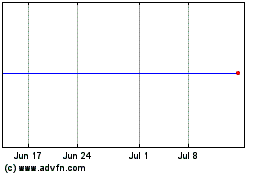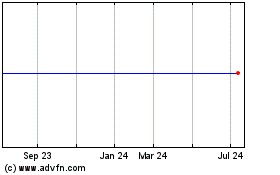AstraZeneca Shares Slip After Profit Warning -- fourth Update
February 04 2016 - 8:53AM
Dow Jones News
By Denise Roland
LONDON-- AstraZeneca PLC warned earnings would fall this year as
it continues to plow investment into research and development and
expects a sharp drop in sales for one of its blockbuster drugs,
surprising investors and sending shares down more than 5%.
London-based Astra said it expected "core" earnings per
share--which strip out exceptional items--to decline in the low to
mid-single digits range in 2016, at constant currencies. That
surprised investors, who had expected the company would keep
earnings guidance flat.
Astra also said that it anticipates sales for Crestor, its
cholesterol drug, to fall this year as its patent expires.
Despite those headwinds, Astra said it would continue to fund
its costly research and development at 2015 levels throughout the
coming year. It said, however, it would "materially reduce" sales
and general administrative expenses to help rein in costs.
In early trading in London, Astra shares were down 231 pence, or
5.2%, at 4182 pence.
The fresh guidance also raised questions over next year's
remuneration of AstraZeneca's top executives, whose pay has
historically been linked to a core EPS target of $4.20--a level
which will be breached should it fall more than 1.4% from this
year's $4.26. Chief Executive Pascal Soriot said the remuneration
committee would make those decisions "when they have the facts in
hand and consider all the elements." He noted that the guidance
included the dilutive effect of Astra's $2.7 billion acquisition of
ZS Pharma and a $4 billion deal to buy a controlling stake in
Acerta Pharma, both announced late last year, and that the
committee would need to decide whether to take that into
account.
The decision to hold research spending steady, rather than
reduce it, shows the pressure AstraZeneca is under as it furiously
pushes a growing pipeline of upcoming drugs, in order to replace
the revenue lost from older drugs, some of which, such as Crestor,
are facing the end of their patent protection. "Investment on
R&D at AstraZeneca has increased quite dramatically over the
past few years," said Sean Bohen, head of global medicines
development. "We now are at a sustainable level and are going to
keep it there."
That pipeline was a key plank in Mr. Soriot's defense against an
unsolicited, and ultimately failed, takeover bid by Pfizer Inc. in
2014. At the time, he promised investors Astra was more valuable as
a stand-alone company because of the growth these new drugs
promised.
The AstraZeneca boss, who has vowed to increase annual revenue
at AstraZeneca to $45 billion by 2023, compared with the $24.7
billion generated in 2015, said he was focused on "building the
long term future of the company."
The profit warning came as Astra posted net income of $808
million in the quarter ending Dec. 31, compared with a loss of $321
million in the year-earlier period. It reported revenue of $6.4
billion, a 5% decrease from $6.7 billion a year ago. Stripping out
the effect of the strong dollar, sales increased 2%.
Core net profit, a measure which strips out certain one-time
items, rose 26% to $1.2 billion. Analysts expected revenue of $6.3
billion and core net profit of $1.2 billion.
The company's financial results were boosted by proceeds from a
series of licensing deals that involve AstraZeneca relinquishing
the rights to develop and commercialize certain drugs in its
pipeline in return for an upfront payment, along with "milestone"
payments garnered along the way if the drug meets certain financial
targets.
In the fourth quarter, AstraZeneca received $192 million from
such deals. Mr. Soriot has said this so-called externalization
strategy allows Astra to focus on the diseases where it has most
expertise while creating value from those drugs that sit outside
these areas.
Product sales, at $6.2 billion, were flat at constant currencies
compared with a year earlier, as the growth of new products helped
offset the revenue decline from Astra's older drugs, which are
facing cheaper competition following the loss of their patent
protection.
AstraZeneca said its so-called growth platforms--the products it
is betting on for future expansion--generated $3.6 billion in sales
in the fourth quarter of the year, up 11% from a year earlier at
constant currencies.
The company said it would pay a second interim dividend of $1.90
per share, bringing the dividend for the full year to $2.80, and
reiterated its commitment to a progressive dividend policy.
Write to Denise Roland at Denise.Roland@wsj.com
(END) Dow Jones Newswires
February 04, 2016 08:38 ET (13:38 GMT)
Copyright (c) 2016 Dow Jones & Company, Inc.
AstraZeneca (NYSE:AZN)
Historical Stock Chart
From Mar 2024 to Apr 2024

AstraZeneca (NYSE:AZN)
Historical Stock Chart
From Apr 2023 to Apr 2024
